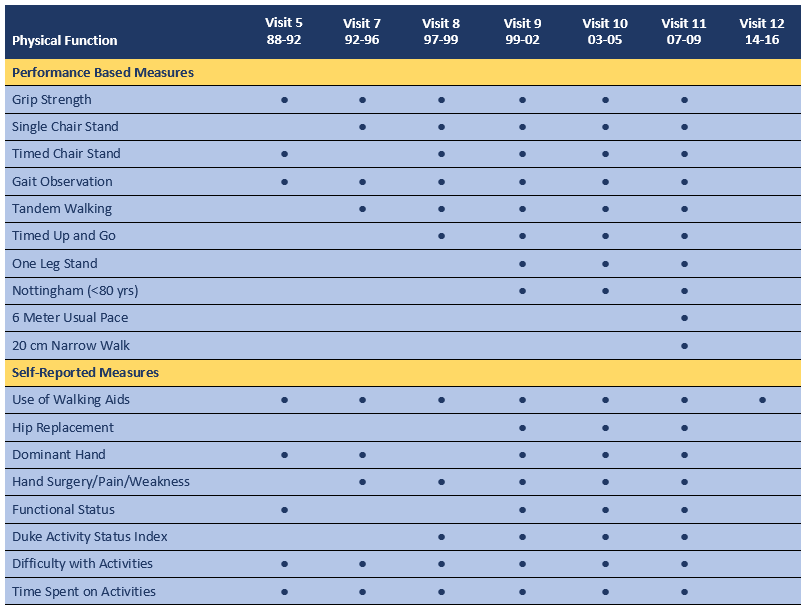Download Physical Function Data Dictionary
Physical Function Tests (PFTs) were introduced at Visit 5 (1988-92) and included at each subsequent research clinic visit except Visit 12. Participants completed performance-based measurements of lower extremity physical function tasks and grip strength. All tests were administered by trained, certified personnel, with consistent administration and scoring across visits.

Performance-Based Measures
Grip strength was measured for each hand twice using a handheld dynamometer1. The maximum grip strength (kg) of each hand is provided. Grip strength was measured with arm bent at a 90 degree angle at the elbow, forearm parallel to the floor, with arm not touching the body. The participant squeezed the dynamometer maximally while lowering the arm during a 3 second count. Conditions that may interfere with performance were noted (e.g. Heberden’s nodes on 2 or more fingers, Dupuytren’s contractures, hand pain or weakness, or recent hand/wrist surgery).
Single Chair Stand: With arms folded and feet flat on floor, participants were asked to stand up from a seated position in a chair. Ability to complete this move without using their arms was noted.
Timed Chair Stand. With arms folded and feet flat on floor, participants were asked to stand up straight from a seated position in a chair five times without using their arms and moving as quickly as possible without stopping. Time to completion was recorded in seconds.
Gait Observation Participants ambulated for an examiner and were assessed with respect to limp, shuffle, arm swing and speed.
Tandem Walking. Participants were asked to walk heel to toe in close succession for six steps. Participants were scored based on number of steps successfully performed. If participant initially had difficulty, but was able to perform the test, this was indicated in the scoring.
Timed “Up and Go” Test (3 meter). Participants were asked to stand up from a seated position in an arm chair, walk to specified point 3 meters distance, turn around walk back and sit down. Participants were instructed to walk at their usual pace. Time to complete was scored in seconds. The task was performed twice.
One Leg Stand. With shoes removed, participants were asked to stand on one leg for 30 seconds, with eyes open. Each leg was tested. Participants were allowed up to 5 attempts for each leg to reach 30 seconds. Number of attempts and longest number of seconds was recorded.
Nottingham Power Rig2. Quadriceps strength was measured on the Nottingham Power Rig (University of Nottingham, Nottingham, England) on participants younger than 80 years of age. The explosive power (watts) of the leg in extension was measured by having the participant push the foot against a flat pedal until the leg was fully extended. Participants were asked to complete three trials per leg.
6 Meter Usual Pace. Time to complete (in seconds) and number of steps was measured as participants walked a 6 meter course at usual pace. Participants were asked to complete two trials.
20 cm Narrow Walk. Time to complete (in seconds) and number of steps was measured as participants walked a narrow (20 cm wide) 6 meter course at usual pace. The trial was scored as “unable to assess” if the participant stepped on or outside the line more than twice. Participants were allowed three attempts. If the first two attempts were successful (2 or fewer deviations from the marked course), the third trial was not administered.
Self-Reported Measures
In addition to the standard questionnaires below, participants were asked whether they ever had a hip replacement prior to administering the Nottingham Power Rig, and were asked about dominant hand and hand issues prior to administering the grip strength test. Participants were also asked about the use of various walking aids.
Functional Status Questionnaire – Participants were asked whether they had difficulty performing typical activities such as walking, going up or down stairs, performing housework, preparing meals, and shopping.
Modified Duke Activity Status Index – In this modified version of the Duke Activity Status Index3, participants were asked whether they engaged in each of 6 activities and whether it was easy or hard to engage in that activity.
Difficulty with Activities – Participants were asked whether difficulty with specific actions interfered with their usual activity.
Time Spent on Activities – Participants were asked how many hours, in a normal day, they spent on specific activities such as sleeping, napping, sedentary activities, housework, childcare, etc.
References
- Kalyani RR, Kim C, Ferrucci L, Laughlin GA, Kritz-Silverstein D, Kong S, Nan B, Barrett-Connor E. Sex differences in the association of fasting and postchallenge glucose levels with grip strength among older adults: the Rancho Bernardo Study. BMJ Open Diabetes Res Care. 2015;3(1):e000086. doi: 10.1136/bmjdrc-2015-000086.
- Bassey EJ, Short AH. A new method for measuring power output in a single leg extension: feasibility, reliability and validity. Eur J Appl Physiol Occup Physiol. 1990;60(5):385–90.
- Hltaky MA, Bouineau RE, Higginbotham MB, Lee KL, Mark DB, Califf RM, et al. A brief self-administered questionnaire to determine functional capacity (The Duke Activity Status Index). Am J Cardiol 1989;64:651-4
